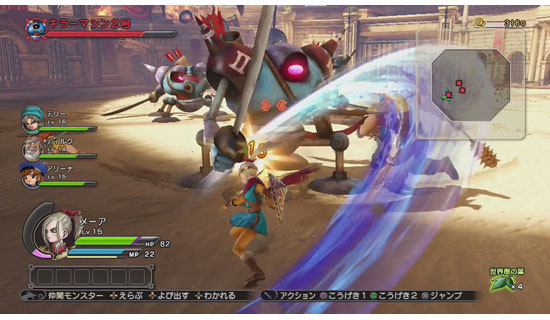Over the last couple of years I’ve really come to enjoy these end of the year posts. Not because I enjoy or even attempt to declare a “Game of the Year”, but because they help me get perspective on the year as a whole in terms of game releases. I even began keeping a list of what I played in 2015, instead of having to scramble to pull it all from memory or play logs. In looking back on this list, I was a little floored by just how many new games I played. There are actually less than I played last year, but the quality of releases and number of them that I truly cared about in 2015 ended up being higher. With that said, these are the new releases that I played this year, in the order that they were released.
Dragon Quest Heroes: yamiryuu to sekaiju no shiro (The World Tree’s Woe and the Blight Below)
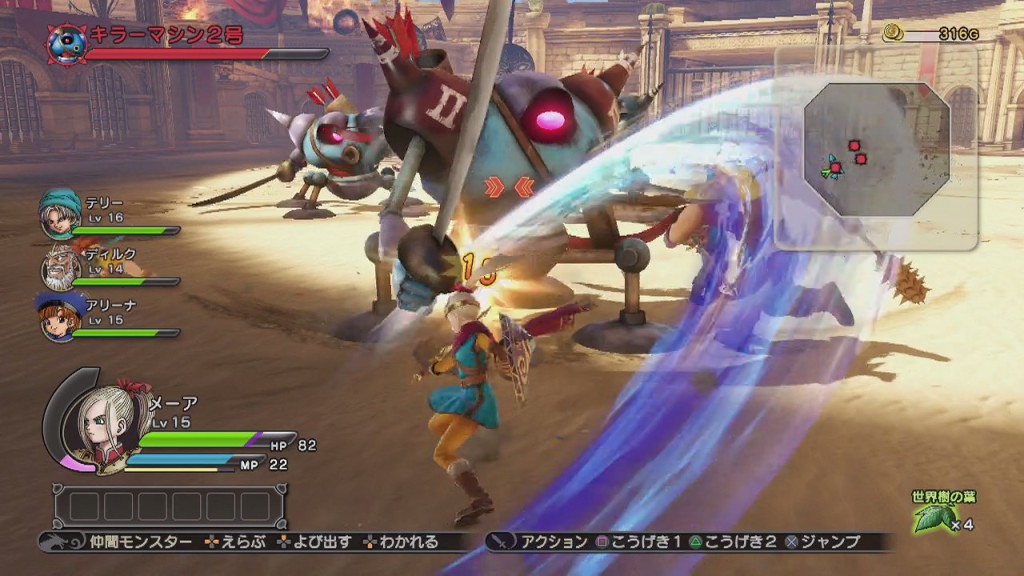
I’m not ashamed to admit I’m very capable of enjoying a good Musou game. This is even more true if it’s based on a franchise that I care about. Last year’s Zelda Musou (Hyrule Warriors) was fairly by the book as far as the licensed games go, but I enjoyed it quite a bit. I expected Dragon Quest Heroes to be on par, but it greatly exceeded my expectations. Sure it still had all the hacking and slashing that the franchise is known for, but it also mixed in heavy RPG and even tower defense elements to spice things up. While I certainly didn’t do everything possible in the game, I played it to completion while actually caring about leveling up my go-to characters. I even tried out a few of the extremely difficult post-game quests. This title is a good thing for both franchises involved, so anyone looking for a slightly different take on either should definitely check it out.
Final Fantasy Type-0 HD
Let’s be honest, this game sold largely because people wanted a code to download the Final Fantasy XV demo as soon as possible. My main reason for buying it at launch was certainly the same, but I’m on record as enjoying the game a lot more than most, despite its problems. In retrospect, it was probably too soon to play through Type-0 again and expect to fully enjoy it. I wrote all about this game as a companion piece to my original Type-0 review. Now that the Final Fantasy XV demo is available to all, I couldn’t give a very compelling reason to pick this one up unless you’ve never checked out Type-0 before. I’ll stand by it being a flawed game that is worth playing, but is ultimately an experience that was designed to be portable. Adjust your expectations accordingly, I guess!
Final Fantasy XV Demo
I don’t typically include demos in these articles, but this one was meaty enough to make an exception for. This was naturally a very anticipated demo, since the game that would become Final Fantasy XV has been being worked on for just about ten years now. I was very excited over the fact that XV’s director was changed from Tetsuya Nomura to Hajime Tabata (who has been responsible for some of what I consider the better Square Enix products of the last several years), and was eager to see any indication as to what that change might actually mean. Given that each numbered Final Fantasy is meant to be a very different experience from any previous games in the series (a fact that some seem to have forgotten), it was of no great shock that XV seems to have a heavy action slant. I have no issues with this, and the combat system was deep and interesting enough for me to complete the demo and do several of the optional pieces. I tried not to think too hard about some of the more ill advised design decisions until I can see them in their intended framework, though that was sometimes difficult. Ultimately the Final Fantasy series has a history of the full games being significantly different from their demos, so we’ll just have to see what happens.
Bloodborne (and The Old Hunters DLC)
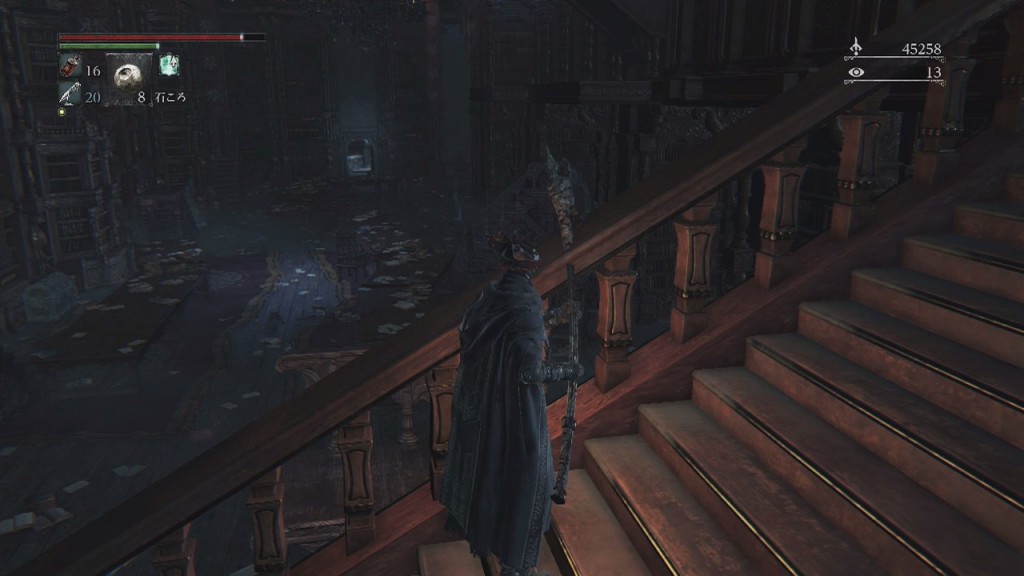
As mentioned above, I don’t typically feel the need to declare a game my own personal “Game of the Year”. But of the games I played this year, Bloodborne (and its recent DLC) is the game I had the most fun with. Though I’ve not written about any of them here yet, I do have a small history with the Souls series: I completed Demon’s Souls several years ago, and played Dark Souls up through Blight Town. The two things that I absolutely love about the Souls series are their mechanics and the vague and intriguing way in which they tell their stories. Bloodborne managed to take those mechanics and make me like them even more (they’re more fast paced yet still deliberate), and completely pulled me in with its Victorian horror meets Lovecraft story and setting. It wasn’t without its problems: The reduction in sheer number of weapons and armor from the Souls series allowed for a significantly fewer amount of viable builds (though I didn’t mind that too much), and the mechanic of having blood vials as consumable items instead of an Estus Flask resulted in completely unnecessary farming (I minded this much more), but not being a complete Souls veteran helped me a lot in overlooking these issues. It also inspired me to take on the project of going back and playing through the Souls games this coming year. I spent a fantastic couple of months savoring this game, and even getting all of the trophies that I reasonably could (that is to say all but the Chalice Dungeon trophy, which perhaps I will revisit in a new game plus). I’m currently about halfway through the DLC (which is a significant amount of content), so I’ll continue enjoying Bloodborne into the new year as well. This is a fantastic starting point for anyone looking to get into the Souls series, as well as something that any Souls veteran may enjoy.
Rodea The Sky Soldier
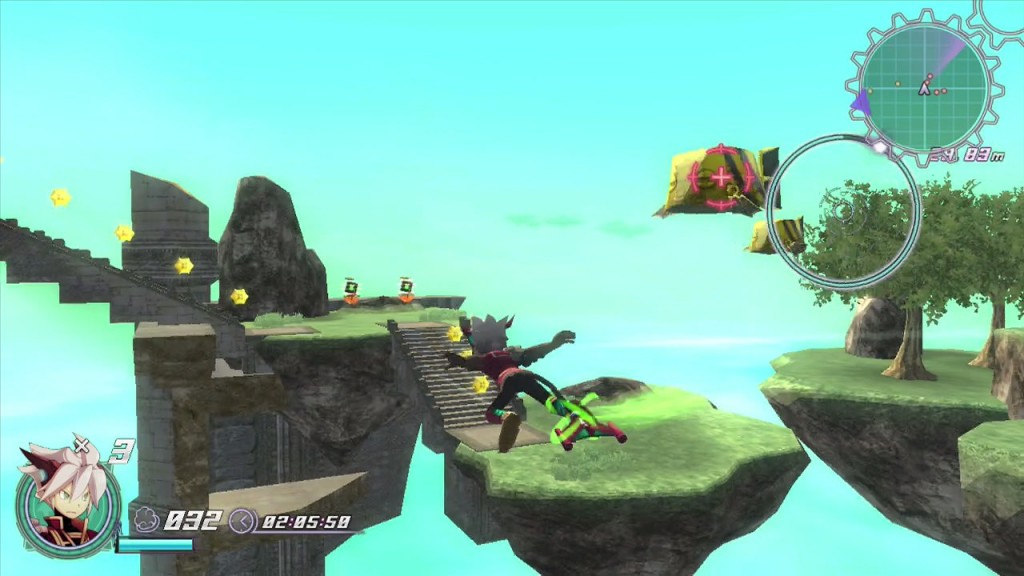
If I were to pick a game that made me feel the complete opposite way that I felt about Bloodborne, it would be Rodea. For those who don’t know Rodea’s troubled history, it began life as a Wii title from Yuji Naka (Ex Sega employee and mastermind behind such notable Sega franchises as Sonic the Hedgehog and Nights Into Dreams) and his company Prope. This title was completed in 2011, and Naka stated that Kadokawa Games was set to publish it. Three years then passed with no word of progress, and in that game the Wii was sunset for the Wii U. Then Kadokawa announced that the 3DS version of the game was nearing completion, and that the console version would be on the Wii U. Later on they would make the surprising announcement that the original Wii version of Rodea would also be included with early pressings of the Wii U version. I foolishly decided that the Wii U version would be the best one to play first. I intend to write on both versions in the future, but the Wii U version is not only way worse looking than it has any right to be, but is one of the most glitchy and non-mechanically sound games that I’ve played in a long time. Only after playing it to completion did I decide to play a couple levels of the original Wii version, and I immediately saw why the Wii U version was so bad: Kadokawa took a game that was originally developed completely around motion controls and turned it into a game with the same ideas, but without any support for motion controls. Whereas the original game has much of that Yuji Naka charm, the Wii U version has no real charm of any kind. Sadly the only way to get the original version is to buy the whole package, but the Wii U game is much better off ignored.
Persona 4: Dancing All Night
Despite being very pleased with how last year’s Persona Q spin-off turned out, I didn’t have very high hopes for what a Persona 4-based dancing game might be like. I love the soundtrack to the Persona games just as much as anyone, but it was very easy for me to see this as a potential huge misstep. I’m happy to say that my suspicions were completely wrong, because I ended up putting a lot more hours into this than I typically do on a rhythm game (I generally like them, but am never very good at them). The soundtrack featured a ton of remixes of many of the songs you know so well, and there were a ton of character-related items to unlock. With difficulties from fairly easy to blisteringly difficult, there’s something here for rhythm game players of every skill level. The only real downside is that the story mode was far too long and text-heavy for a rhythm game, even one that’s based on Persona. Luckily you can skip as much of the story text as you like, so that should be no barrier to playing this if you like the Persona franchise or rhythm games in general.
Yoshi’s Woolly World
Like many others, I absolutely loved Yoshi’s Island. I had never played the DS or 3DS sequels, and never felt particularly inspired to since the popular opinion was always that they just didn’t measure up. I had no intention of even buying Yoshi’s Woolly World (despite the awesome Amiibo that came packed in with it), just assuming that the same would apply here. When I started hearing favorable previews of the title, I got so hopeful that I pre-ordered it right away. Those previews were all correct. I had my doubts at the very beginning when the game comes off as a little too easy, but by the time you hit World 2 there are already a ton of new ideas on display. It just keeps getting better for there. Not only did Yoshi’s Woolly World manage to preserve all of the things that made the original Yoshi’s Island great (unless you really just can’t do without Baby Mario), but it even takes many of the levels in different and unexpected directions. Many of them actually made me smile, and a platformer hasn’t managed to do that in awhile.
Gundam Battle Operation NEXT
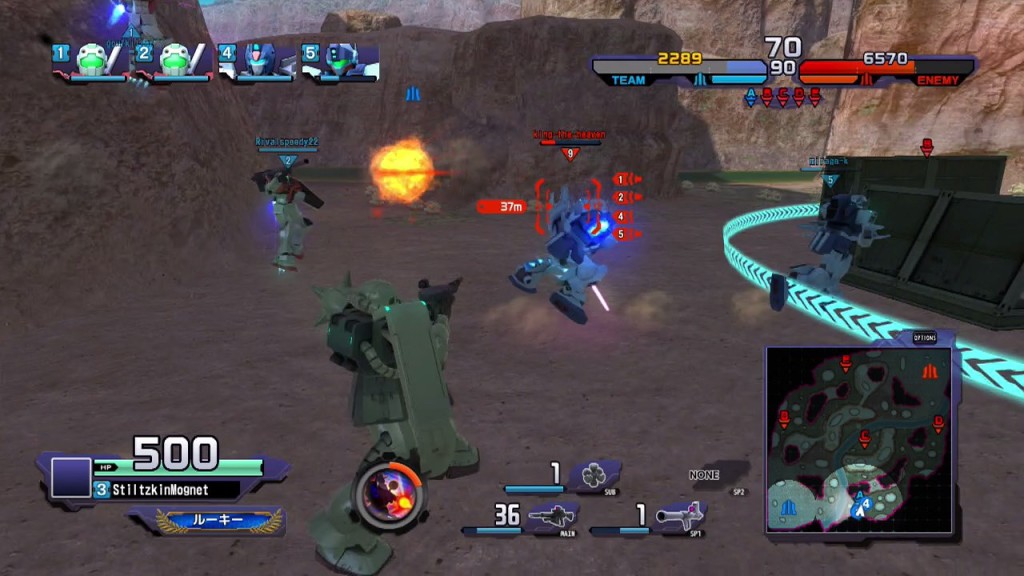
Many may not realize that a handful of free-to-play PlayStation 3 and Vita games were shut down this year, after relatively short life spans. While most of them were not games that I particularly cared about, that got me thinking about one that I’d had on my PlayStation 3 for some time: Gundam Battle Operation. There have no been no announcements that it will be shut down, but I realized I’d had it on my console since 2012 and have only played it a handful of times. It was just one of those games that I’d lost track of, though I remembered it being a pretty good arcade style game that put you inside of a Mobile Suit. When I revisited it, the player base seemed to have dwindled down to the point where it’s difficult to easily find matches. Right around the same time I was pleasantly surprised to see that a sequel was being released: Gundam Battle Operation NEXT. Unlike the first Battle Operation, this sequel took a form much closer to the Gundam Vs. series (Which is a series I know of but don’t have much experience with) in its mechanics and style of play. In other words, it’s the frantic and fast action counterpart to the original Battle Operation’s slower and more deliberate pace. While there was a certain amount of frustration in frequently being beaten by those who bought their upgraded Mobile Suits with real money or just put in a whole lot more time than me, I had a great time with this game and played it every day for at least a month. I may even go back to it at some point, though by then most of the player population will be too far ahead of me. Like with Bloodborne, it’s also made me want to go back and check out some of the Gundam Vs. games that I’ve missed.
Metal Gear Solid V: The Phantom Pain
After liking the direction last year’s MGS V: Ground Zeroes was taking the series and all of the Konami/Kojima controversy surrounding the release of The Phantom Pain, there was no way that I wasn’t playing this one right away. In many ways it’s exactly what I was hoping for, and in many ways it was something else entirely. I should start by saying one of my favorite entries in the series in Peace Walker, and that’s mainly because of its mission-based structure that made for a better MGS experience on a portable system. MGS can get a bit harrowing for me when it isn’t broken up into smaller missions, maybe because I’m not actually very good at these games. The Phantom Pain takes a huge page from Peace Walker’s book in its mission-based structure, but also introduces the idea of having a pseudo open world. I say “pseudo” because you have boundaries that you cannot leave in each mission, but those boundaries are rather expansive compared to Peace Walker. Combined with all of the Mother Base resource management that The Phantom Pain wants you to do, I was left feeling very overwhelmed early on. At some points I literally had to take a deep breath and tell myself to do just do the missions and let the Mother Base staffing do its own thing on auto, slowly working my way through the metric ton of unlockable guns and other gear. Once I was able to do that, I had a much better time. It’s obvious that this game had some amount of troubled production, because the story is very fractured at certain points and the ending comes very suddenly. The main part of the game also felt too long. This may be because of my skill level, but I felt that quite a few of the required story missions could have been made into Side-Ops, or simply optional missions. Regardless, I’m glad that I was there for the series’ send-off (at least as far as I’m concerned), and I’ll certainly go back and revisit several of the older titles in it over time.
Super Mario Maker
Super Mario Maker is the realization of all the wild Super Mario Bros. tales that you heard (or maybe helped tell) on the playground at school (at least if you’re around my age). Though I haven’t put nearly the time into it that I’d hoped to at this point (MGS V edged it out for my time), it’s an absolutely amazing tool set. I’ll admit that I’m not a particularly great level creator though, and so I prefer to consume everyone else’s creations instead. The creation tools are intuitive and extremely easy to use, though I wish they weren’t dripped out to you quite so slowly as they are. I’ve only created three levels, so I’ve not unlocked anywhere near the entire tool set, nor even the ability to switch between all the various Super Mario games. But even around the many automatic levels where you don’t need to touch the controller and blisteringly hard levels that are hard to believe that the creator was able to clear themselves, there are some real gems. It serves as a great game to put in for a semi short period of time and just see what kind of levels are out there, and will continue to be that for some time.
Monster Hunter X
I was afraid with how into Monster Hunter 4G I was, that I would end up quickly putting down X. Now just over the 50 hour mark since its release, that doesn’t seem to be the case! Monster Hunter X does what past MH games have dabbled in (most notably Portable 3rd on the PSP): Complete and utter Monster Hunter series nostalgia. It’s a cheap tactic, but it’s absolutely working on me. In addition a brand new village for this game, you also can visit and accept quests from Kokoto (original MH series village), Pokke (Monster Hunter 2nd series village) and Yukumo (Monster Hunter Portable 3rd village). In addition the monster cast is an all-star one, as it brings together a large portion of the monsters from all previous games along with some new ones. The amount of content as a result of this is simply staggering, and even with as far in as I am now I find it hard to see myself completing every quest. There are also more weapons to choose from then ever (including the ability to play as a Felyne, which I’ve only dabbled in), augmented further by each weapon having four distinct styles that it can be used in. Despite how complicated all of this sounds, it isn’t overwhelming at all if you have any kind of previous MH experience. I’ll admit I often fallback into the ways that I’ve always fought these monsters instead of taking advantage of the new styles, but I’m working on it. I’ll certainly be playing this game well into the new year!
What have I learned from playing all these games this year? I definitely learned that it didn’t leave me with nearly enough time to explore all of the retro titles that I wanted to (which I tend to write about here more than current releases), even though it was nice to feel more up on current releases. There were a few games in here that I could have gone without having right away as well. So as both a time and money saving measure for next here, I’m going to more carefully examine whether I really feel like I need to have a new release right away or not before I click that pre-order button. I’ve said this before, but I’d really like to get into the habit of spending more time writing and analyzing about what I play here, instead of just mindlessly consuming it. I don’t believe in waiting until the New Year to make changes, but this time I’ll be like everyone else and say that after having spent some time with friends and family around Christmas I’m going to get back into the swing of this!
